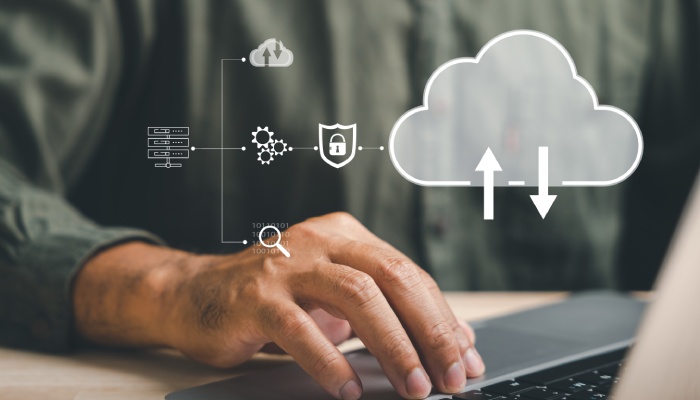Cybersecurity risks are accelerating as businesses adopt emerging technologies. Threat actors have more sophisticated tools at their disposal than ever, which they are employing for various malicious activities, begging the need for a security-first approach to deal with the evolving threats. Businesses need to assess the risks of cybersecurity and educate themselves with the latest, so they understand how crucial it is to develop a cybersecurity strategy for today and tomorrow.
Key Statistics
These are the latest cybersecurity statistics to help understand the risk cybercrimes pose to a business and how big the cybersecurity market is:
- The role of AI in cybersecurity will grow with machine learning systems and reach nearly $46.3 billion by 2027.
- The average cost of a data breach rose to its highest ever at $4.24 million in 2021.
- Nearly 80% of organizations have experienced a cloud data breach in the past two years.
- Over 200 zettabytes of information will be stored in the cloud worldwide by 2025.
Imminent Cybersecurity Threats that are Impacting Businesses
There are three main critical areas that businesses need to address to avoid significant losses, which are:
The Ever-growing Data and Information on the Cloud
Data is critical to modern businesses since it allows for targeted marketing, appropriate recommendations, and a bespoke customer experience, providing businesses with a market edge. Organizations must deal with a wide range of data and vital information that may be accessed via numerous endpoints now that wireless technologies, teleworking, and hybrid workspaces maintain a presence. Since most organizations have moved to cloud operations and services to meet rising demand, there is a more significant concern of data breaches from individuals, insiders, contractors, vendors, and partners, necessitating a more sophisticated cybersecurity strategy.
Businesses must examine the cloud security and data breach vulnerabilities they face. So they can take steps to defend themselves against ransomware, malware, denial of service, and data breach attacks, which may cause an enterprise to collapse due to a decline of customer confidence, imposed regulatory fines, and brand degradation.
Artificial Intelligence for Sophisticated Cybercrimes
Artificially intelligent systems, machine learning algorithms, and automation are tools for transforming the world. But these are weapons in the hands of cybercriminals, who can utilize automation and artificial intelligence to extract information, deploy malware, ransomware, or carry out other malicious activities in a matter of hours. Microsoft experienced an impersonation phishing scam in 2021 where employees received phishing emails redirecting them to websites designed for stealing their credentials. These sophisticated phishing attacks involved advanced tactics that only triggered the attack after confirming the employee’s identity, changing the phishing link for others.
Businesses need to know the current scenario about automation and AI systems that can increase the sophistication and occurrence of cybersecurity attacks. Furthermore, the increase of the cybercrime-as-a-service model has enabled cybercriminals to launch ransomware and malware attacks quickly.
Lack of Talent, Resources, and Experience in Cybersecurity
Large organizations might have dedicated cybersecurity teams, but SMBs and SMEs lack sufficient talent, resources, and expertise to deal with cybercrimes. There is a lack of education regarding the best cybersecurity practices in most organizations. Moreover, cybersecurity risk management is not a quick process, especially when businesses are unsure how to manage and control such risks as the technological advancements and transformations are leaps beyond cybersecurity risk management procedures and methodologies.
In addition, the growing and changing regulatory compliance requirements are putting pressure on businesses as they have to ensure privacy and protection of data.
How Businesses Can Mitigate the Looming Cybersecurity Threats
There are specific defenses against these crucial cybersecurity threats. Businesses can ensure protection in 2022 and beyond by focusing on these strategies:
Mitigating Cloud and Data Risks
- Zero Trust Policies: Zero-trust policies involve trusting zero sources and validating each step online. A zero-trust approach can help protect against cloud and data risks, significantly reducing cyberattacks by verifying identities and access at every point.
- Using Behavior Analytics: Insider threats and employees experiencing social engineering tactics by cybercriminals in an attempt to compromise a businesses’ cloud network can be eliminated by monitoring employee behaviors for anomalies.
- Homomorphic Encryption: Homomorphic encryption can reduce risks associated with third-party vendors and partners and help ensure better data privacy, allowing computations without decrypting data.
- Log Monitoring: A flexible log monitoring system for accessing specific logs for analysis and visualization can ease log management procedures for identifying potential threats instead of monitoring big data.
Automation against Automation for mitigating AI-assisted cybercrimes:
- Automated Tools: Automated tools for remote processes and smart systems for analyzing risks and automatic patching can help protect lower-risk elements, freeing up human elements for better productivity.
- Defensive AI Systems: Artificially intelligent agents can help businesses eliminate risks by recognizing patterns and behavior and optimizing workflows. Furthermore, automated agents for handling malicious activities and advanced MFA (Multi-Factor Authentication) can help strengthen a businesses’ cybersecurity posture.
Addressing Resources, Gaps, and Regulatory Compliance via Enhanced Procedures:
- Embedded Security in Software Development: Cybersecurity should not be considered a second thought and should instead be involved as a crucial step to ensure secure software development and help educate developers on the job.
- Standardizing Infrastructure: Enforced cybersecurity standardization can provide seamless management of cloud environments and help employees adopt a security-first approach.
- Detailed Policies: Businesses can adhere to strict compliance requirements by maintaining strict records and clear bills highlighting specifics about software components and ensuring the preparation of security professionals in case of inquiries. A software policy can include development procedures, code-scanning tools, and email security standards.
- Adopting Service Models: Businesses can invest in excellent cloud providers with advanced automated solutions and scalability to ensure a safer, more straightforward, and diversified environment that can help divide cybersecurity responsibilities.
Final Words
In today’s business world, the digital revolution and cybersecurity needs are imminent and go hand in hand. Each technological advancement that an organization invests in and implements comes with its cybersecurity concerns.
Businesses that want to establish themselves advantageously for 2022 and the coming years should adopt a rigorous and strategic approach and take cybersecurity as a responsibility. The said cybersecurity solution lies in reinforcing policies, aligning resources to prevent the most significant and impending risks to cybersecurity, and implementing the risk mitigation measures as discussed above.


